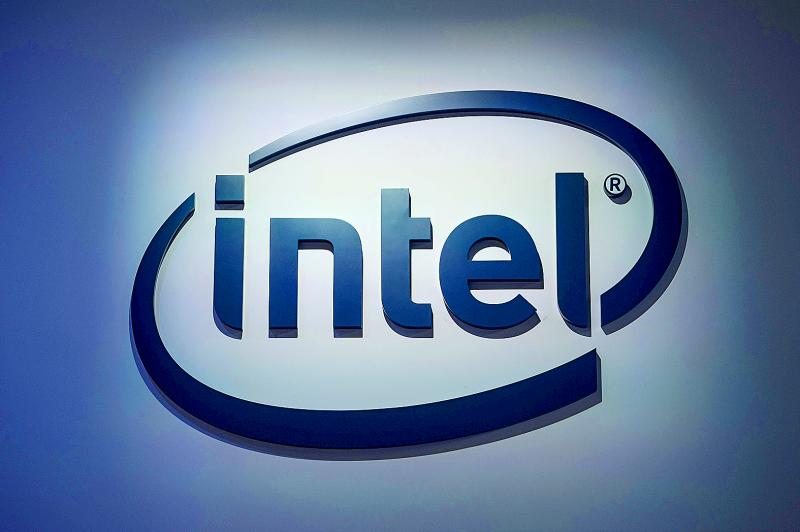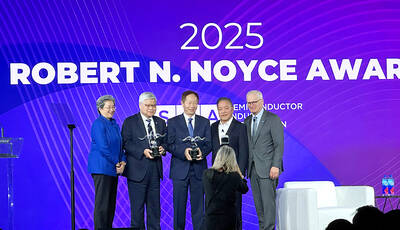Intel Corp shares on Thursday slumped after a surprise drop in data center sales and a tepid forecast added to concern that the company is losing its lead in processors.
The data center business, a major source of Intel profit, suffered a 10 percent decline in third-quarter revenue compared with a year earlier after a weak economy hurt sales to large companies and governments.
Sales to cloud computing providers would slow in the fourth quarter, Intel said.

Photo: AFP
Falling prices and narrowing profit margins reinforced concern that Intel is losing its lead in chip manufacturing technology, exposing the company to the strongest competition it has faced in more than a decade.
During a conference call, Intel chief executive Bob Swan said that he is still deciding how much production to outsource.
Executives also said that the COVID-19 pandemic had increased demand for cheaper chips and predicted those headwinds would pass.
Loop Capital Markets analyst Cody Acree said that he did not accept Intel’s use of the pandemic as a reason for the quarterly revenue decline, citing a boost in demand for PCs during the past few months.
“I didn’t hear any answers to the biggest questions,” Acree said.
Intel shares fell about 10 percent in extended trading on Thursday.
The company projected that fourth-quarter sales would decline at their worse rate in more than a decade. Gross margin, a key indicator of profitability, would end the year below 60 percent for the first time in seven years, it said.
The company experienced a very different third quarter compared with its expectations entering the period, Intel chief financial officer George Davis said.
“We saw a big change in our data center demand profile, with enterprise and government dropping 47 percent year-over-year after being up 30 percent for two consecutive quarters.” Davis said.
Average selling prices for Intel’s data center chips dropped 15 percent from a year earlier, suggesting competition is rising in a lucrative market that the company has long dominated.
Intel is in the midst of its worst crisis in at least a decade.
The company has been the largest chipmaker for most of the past 30 years by combining the best designs with cutting-edge factories. Most other US chip companies have shut, or sold plants and tapped other firms to make the components. Intel held out, arguing that doing both improved each side of its operation and created better semiconductors.
That strategy is now being questioned.
Revenue in the fourth quarter would be about US$17.4 billion, the Santa Clara, California-based company said in a statement.
That was in line with the average analyst prediction, but it would mean sales falling 14 percent year-on-year.
Swan in July announced delays to Intel’s 7-nanometer production process. Production techniques play a crucial role in the performance of processors and what it costs to make them.
Intel had led the US$400 billion chip industry in that area for three decades. Now rivals such as Advanced Micro Devices Inc can get products made with more advanced techniques by Taiwan Semiconductor Manufacturing Co (台積電).
The firm said that it would decide early next year whether to push forward with in-house 7-nanometer production or outsource it.
Swan said that it would probably be a mixture of the two.
Economics, timing and the performance of chips would determine the decision, the company said.
Third-quarter earnings per share, excluding some items, were US$1.11, while revenue was US$18.3 billion, down 4 percent year-on-year.
Analysts were looking for earnings per share of US$1.10 on revenue of US$18.2 billion.

Shiina Ito has had fewer Chinese customers at her Tokyo jewelry shop since Beijing issued a travel warning in the wake of a diplomatic spat, but she said she was not concerned. A souring of Tokyo-Beijing relations this month, following remarks by Japanese Prime Minister Sanae Takaichi about Taiwan, has fueled concerns about the impact on the ritzy boutiques, noodle joints and hotels where holidaymakers spend their cash. However, businesses in Tokyo largely shrugged off any anxiety. “Since there are fewer Chinese customers, it’s become a bit easier for Japanese shoppers to visit, so our sales haven’t really dropped,” Ito

The number of Taiwanese working in the US rose to a record high of 137,000 last year, driven largely by Taiwan Semiconductor Manufacturing Co’s (TSMC, 台積電) rapid overseas expansion, according to government data released yesterday. A total of 666,000 Taiwanese nationals were employed abroad last year, an increase of 45,000 from 2023 and the highest level since the COVID-19 pandemic, data from the Directorate-General of Budget, Accounting and Statistics (DGBAS) showed. Overseas employment had steadily increased between 2009 and 2019, peaking at 739,000, before plunging to 319,000 in 2021 amid US-China trade tensions, global supply chain shifts, reshoring by Taiwanese companies and

Taiwan Semiconductor Manufacturing Co (TSMC, 台積電) received about NT$147 billion (US$4.71 billion) in subsidies from the US, Japanese, German and Chinese governments over the past two years for its global expansion. Financial data compiled by the world’s largest contract chipmaker showed the company secured NT$4.77 billion in subsidies from the governments in the third quarter, bringing the total for the first three quarters of the year to about NT$71.9 billion. Along with the NT$75.16 billion in financial aid TSMC received last year, the chipmaker obtained NT$147 billion in subsidies in almost two years, the data showed. The subsidies received by its subsidiaries —

Taiwan Semiconductor Manufacturing Co (TSMC) Chairman C.C. Wei (魏哲家) and the company’s former chairman, Mark Liu (劉德音), both received the Robert N. Noyce Award -- the semiconductor industry’s highest honor -- in San Jose, California, on Thursday (local time). Speaking at the award event, Liu, who retired last year, expressed gratitude to his wife, his dissertation advisor at the University of California, Berkeley, his supervisors at AT&T Bell Laboratories -- where he worked on optical fiber communication systems before joining TSMC, TSMC partners, and industry colleagues. Liu said that working alongside TSMC